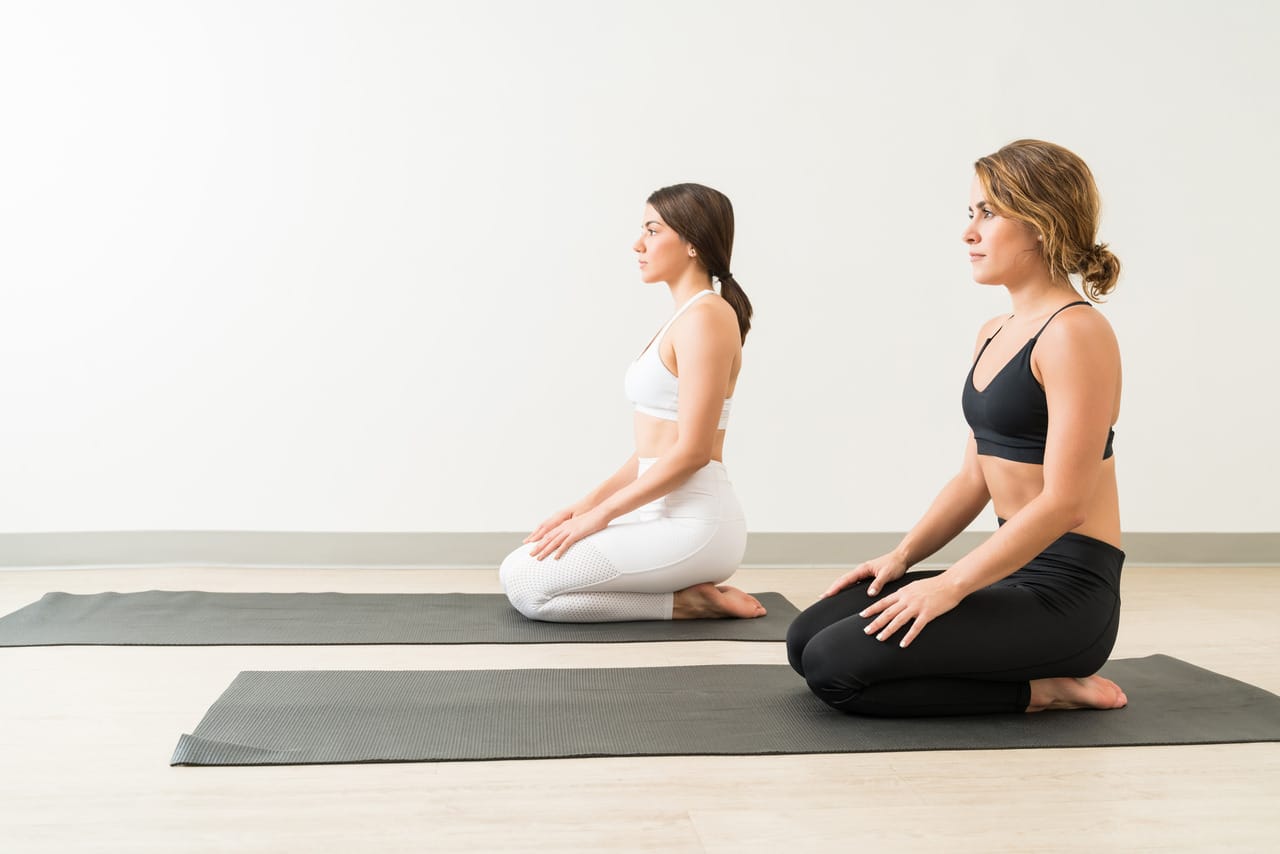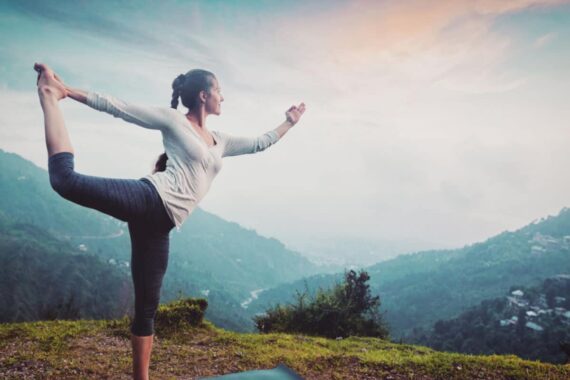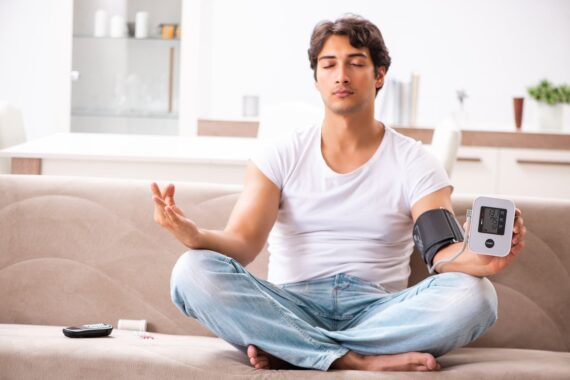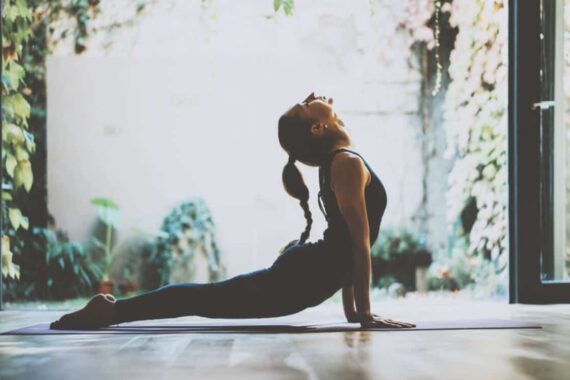
Exploring The Health Benefits Of Vajrasana: HealthifyMe
Vajrasana derives its name from the divine weapon “Vajra”, which belongs to Indra, the king of Gods, as per Hindu beliefs. Vajra is one of the most potent weapons in the celestial universe. The pose is so powerful that it gets its name from Vajra, which also means thunderbolt. This posture is integral to a yogi’s progress in the path of his Sadhana.
Another school of thought connects the position with a Nadi that is linked to the Muladhara chakra. As per that theory, practising this pose curtails high sexual energy. It is known as the adamant pose or the diamond pose because of the firmness of the position and Vajra, meaning diamond, respectively.
How to Perform Vajrasana: A Step-by-step Guide
- Starting Position: Sit back on your heels, bringing your knees, legs, and feet together.
- Body Alignment: Maintain a straight back throughout and keep your neck relaxed.
- Hand Placement: Rest the palms of your hands facing downward on top of your thighs.
- Breathing: Inhale gently through your nostrils.
- Duration: Sit in this position for at least three minutes.
- Repetitions: One can hold the Vajra-asana for a duration that feels comfortable, depending on the level of practice. Thirty seconds to 1 minute is a great starting point.
Variations of Vajrasana
Supta Vajrasana
It is popular in Ashtanga Vinyasa Yoga and is the reclining variation of Vajrasana, known as Supta Vajrasana. In this pose, the yogi gracefully reclines backwards. It requires both strength and flexibility. It’s a posture that encourages practitioners to connect with their breath, find balance, and enhance their sense of calm and well-being.
Laghu Vajrasana
In another advanced form, yogis following Ashtanga Vinyasa Yoga and Iyengar Yoga practice Laghu Vajrasana. This posture is challenging, as it demands a heightened level of strength, balance, and precision. Laghu Vajrasana is a complicated pose, with the thighs raised halfway from the seated position, requiring the engagement of core and leg muscles. The crown of the head makes contact with the floor, offering stability while the hands securely grasp the ankles. It’s an intricate advanced asana that not only showcases the practitioner’s physical prowess but also demands a deep level of concentration and mental focus.
Vajrasana with Gyan Mudra
Vajrasana, a fundamental pose of daily yoga practice, combines seamlessly with the Gyan Mudra to form a duo that promotes overall well-being. In Vajrasana, the body is stable, strengthening pelvic and lower back muscles, enhancing knee joint flexibility, and improving posture. Meanwhile, the Gyan Mudra, with its thumb and index finger connection, provides mental focus and serenity.
When one practises these two together, one creates a deep alignment with the outer and inner world. Vajrasana grounds the physical body, while the Gyan Mudra deepens mental connection. This synergy can help alleviate stress, enhance digestion, and bring about inner peace. Together, Vajrasana and the Gyan Mudra are the dynamic duo toward holistic wellness, elevating the practice to new heights.
Summary
An extended form of vajrasana called Supta vajrasana helps practitioners to establish balance, connect with their breath, and feel more at ease and in control of their bodies. The posture known as Laghu Vajrasana is challenging because it requires a high degree of strength, balance, and accuracy. It also necessitates a high degree of mental attention and concentration. Vajrasana combined with Gyan Mudra promotes calmness and mental focus.
The Functional and Anatomical Aspect of Vajrasana: Top Benefits
Vajrasana improves blood flow in the pelvic and abdominal regions while also strengthening the pelvic and lower back muscles. It pays special attention to muscles like the Iliacus and Psoas Major, which are essential for hip flexion, as well as the adductor muscles that prevent it. Through regular practice, Vajrasana helps make the Iliacus and Psoas muscles stronger and gradually increases the flexibility of your adductors through extended stretching. It also boosts the flexibility and strength of the knee joint. When you sit in this pose, it supports a stable posture by engaging various muscles in the head, neck, and back. As a practice, it not only strengthens your back and pelvis but also provides excellent stability in a meditative posture.
Vajrasana positively affects blood circulation, directing more blood to your abdomen, pelvis, heart, and head, which, in turn, enhances the efficiency of your digestive system by improving the function of various digestive organs and glands.
Here is a closer look at the benefits of vajrasana:
Strengthens Muscles
Vajrasana improves stability and tone of the knee joint, as well as muscles in the thigh, leg, and back. Regular practice strengthens muscles such as Iliopsoas, erector spinae, quadratus lumborum, adductors, and calf muscles, making it suitable for those with muscle tremors or weakness.
Better Digestive Health
Vajrasana reduces bloating and regulates bowel motions to help treat constipation. It is ideal for treating digestive disorders by increasing blood flow to digestive organs and helping with issues like stomach heaviness, hyperacidity, constipation, intestinal gas, and piles. This pose also enhances arterial supply to vital organs like the heart and brain, increasing their efficiency.
Meditation and Mental Well-being
A versatile posture ideal for meditation, providing stability and equilibrium for the body and mind. It facilitates relaxation, concentration, and overall peace of mind.
Relief from Pain
It is helpful for individuals dealing with sciatica and lower back problems, as well as muscle aches in the lower extremities.
Heel and Calcaneal Spurs
It can provide relief from heel pain and gradually reduce calcaneal spurs with regular, daily practice over several months.
Summary
Vajrasana stimulates the digestive system and increases blood flow to the abdominal organs, which aids in better digestion. Vajrasana promotes relaxation and helps calm the mind, which in turn reduces tension and anxiety. By strengthening the back muscles, vajrasana helps alleviate back discomfort while improving posture. Vajrasana can help lessen oedema and inflammation in the legs and feet by enhancing blood circulation to the lower body. It reduces stiffness in the muscles and improves flexibility in the thighs, hips, knees, and feet, among other lower body muscles. Vajrasana may also be beneficial for gout and heel discomfort caused by calcaneal spurs.
Ideal Frequency of Performing Vajrasana
The frequency of practising Vajrasana can vary based on physical condition and level of practice. If you aim to enhance flexibility, stability, and overall well-being, daily practice is an absolute must, starting with shorter sessions and gradually extending the duration as the body becomes more accustomed. Alternatively, practising every other day might be a good choice for those seeking the benefits without a daily commitment.
If one has a hectic schedule, frequent but shorter sessions throughout the week can also yield positive results. Regardless of the chosen frequency, it’s essential to remain in tune with the bodily signals. Any signs of pain, discomfort, or numbness should need prompt adjustments, rest, or consultation with a professional. Ultimately, the frequency should align with objectives and physical capabilities, emphasising gradual progress and attentive self-care to enjoy the advantages of Vajrasana safely.
Summary
Depending on one’s level of practice and physical state, Vajrasana practice frequency can vary. Consistent daily practice is essential for improving overall well-being, flexibility, and stability. For beginners, begin with a short period in Vajrasana and gradually extend it as the body adjusts to the posture. Shorter, more frequent sessions spread out throughout the week might also be beneficial if one has a busy schedule. However, if one feels any pain or discomfort when doing Vajrasana, stop immediately and change the position or utilise props to make it more comfortable.
Vajrasana and Emotional Well-Being
This seated posture is often associated with a sense of grounding and stability, connecting one to the earth element and the present moment. It is beneficial for those dealing with anxiety or stress as it helps calm the mind. Vajrasana is an ideal position for meditation due to its capacity to maintain a straight and aligned spine, fostering a comfortable and stable foundation for focus and concentration. Meditation itself is a potent practice for emotional well-being, known to reduce stress, anxiety, and depression while promoting feelings of peace and contentment.
Vajrasana encourages mind-body connection, enhancing awareness of physical sensations, thoughts, and emotions, a crucial element for managing and improving emotional well-being. By paying close attention to the breath in Vajrasana, one can engage in breath awareness, a vital component of many meditation techniques, with the potential to significantly impact the emotional state. Deep, mindful breathing can effectively reduce stress and induce relaxation. Some practitioners find that holding this posture can lead to the release of trapped emotions.
Summary
Vajrasana is a mind-calming pose that is helpful for people experiencing anxiety or stress. To manage and enhance emotional well-being, Vajrasana promotes the mind-body link by increasing awareness of thoughts, feelings, and physical sensations. Vajrasana encourages one to practise breath awareness, which is an essential part of many meditation practices.
Risk and Precautions for Vajrasana
While Vajrasana is generally safe, there are several measures to take to avoid injury or pain. Consider the following precautions before performing Vajrasana:
- Not suitable for individuals with stiffness in the foot, ankle, and knees.
- It is not ideal for those with conditions like slipped discs or arthritis in knee or ankle joints.
- Avoid in cases of hypotension (low blood pressure) and during pregnancy when extra weight could strain knee joints.
- Avoid prolonged practice, especially if ankles and knees are not sufficiently flexible to prevent straining ligaments.
- Perform the pose only as long as it feels comfortable, as prolonged sitting in Vajrasana can lead to numbness and potential peroneal nerve paralysis, causing a “Yoga Foot Drop” syndrome where ankle flexion is impaired when stepping forward.
Summary
If you experience severe knee or lumbar discomfort or if you have asthma, avoid this pose. Additionally, if you’ve undergone stomach or knee surgery, you must refrain from it. Do not practise for too long, especially if you do not have enough flexibility in the knees and ankles. Pregnant women should refrain from doing vajrasana because the added weight may put a strain on their knee joints, particularly in cases of hypotension (low blood pressure).
HealthifyMe Suggestions
Practising yoga can provide a wide range of benefits to you since yoga promotes overall well-being. It’s not only a way to lose weight and stay healthy physically but a way to heal your mind and spirit as well. If you are just starting your journey with yoga, it is best to seek professional advice to reap the benefits correctly and to prevent injuries to yourself. At HealthifyMe you can connect with a host of yoga coaches dedicated to helping you on your wellness journey.
The Final Word
Vajrasana is an easy pose with a multitude of benefits. Be it digestive health, posture correction, lower back pain and sciatica, it is helpful to many. However, it’s essential to approach Vajrasana with care and mindfulness, considering any physical limitations or discomfort. If one has physical issues or limitations, consulting a yoga instructor or healthcare professional is advisable to ensure safety. Keep in mind that well-being is a multifaceted issue. While yoga and meditation can be valuable tools, they are most effective when integrated into a comprehensive approach to health and well-being.
Disclaimer: The purpose of this article is just to disperse knowledge and raise awareness. It does not intend to replace medical advice from professionals. For further information, please contact our certified nutritionists Here.
Frequently Asked Questions
Q: What is Vajrasana?
A: Vajrasana is a powerful yoga pose where the practitioner sits on their heels, maintains a straight back, and breathes gently with awareness.
Q: How is Vajrasana performed?
A: One needs to sit back on their heels while bringing knees, legs, and feet together. During the practice, the back has to be straight and the neck relaxed. Once the position is stable, rest the palms of their hands facing downward on top of the thighs. Ensuring that breathing is gentle and done through the nostrils.
Q: What are the potential benefits of practising Vajrasana regularly?
A: Regular practice of Vajrasana can improve posture and strengthen back muscles while enhancing digestion and promoting mental focus and relaxation.
Q: Can Vajrasana aid in digestion and relieve digestive issues?
A: It is excellent for regulating digestive disorders. Vajrasana increases blood flow to digestive organs and improves issues like stomach heaviness, hyperacidity, constipation, intestinal gas, and piles.
Q: Does Vajrasana help with posture and spine health?
A: Vajrasana improves posture as it entails maintaining a straight back. It also opens up the chest. As a result, it strengthens the muscles supporting the spine, promoting better spinal health. Regular practice improves spinal alignment, aiding in posture correction.
Q: How can Vajrasana promote mental clarity and concentration?
A: Vajrasana builds a mind-body connection through regulated breathing, which ensures a sense of calmness and focus. As a result, there is a de-cluttering of the mind, which improves mental clarity and concentration.
Q: Is Vajrasana suitable for people with knee or joint problems?
A: Vajrasana can be difficult for individuals with knee or joint problems. It places a lot of pressure on the knee joints and ankles, potentially causing discomfort or exacerbating existing issues.
Q: What is the impact of Vajrasana on blood circulation?
A: It increases blood flow to digestive organs, helping with issues like stomach heaviness, hyperacidity, constipation, intestinal gas, and piles. It also improves arterial supply to vital organs like the heart and brain, improving their performance.
Q: Are there any contraindications or precautions for practising Vajrasana?
A: It is not good if one has foot, ankle, or knee stiffness, slipped discs, or arthritis. Also, one needs to avoid it if suffering from hypotension. One must take precautions during pregnancy to prevent straining knee joints.
Q: Can Vajrasana be part of a daily routine for overall well-being?
A: Yes. It can be part of a daily yoga routine, depending on the practitioner’s ability and physical condition.
Q: How long should one hold Vajrasana to experience its benefits?
A: Thirty seconds to a 3-minute hold after meals is a good starting point. However, there is no golden number. One should practise as per capacity.
Q: Are there variations or modifications of Vajrasana for different needs?
A: Supta vajrasana, Laghuvajrasana and combining different mudras provide variations to the practice.
Q: Can Vajrasana help with stress and anxiety management?
A: Yes, focusing on breathing and centring one’s mind helps reduce stress and anxiety.
Q: Is there scientific research supporting the benefits of Vajrasana?
A: There are several studies supporting the benefits of Vajrasana by eminent researchers attached to the academia or clinical part of healthcare.
Q: What are the potential effects of Vajrasana on spiritual and emotional health?
A: Vajrasana is known to create a grounding effect on the practitioner with prolonged practice. Once the mind is calmer, it impacts emotional health positively. Spiritualism is a journey, and a meditative pose is at the very core of it. Vajrasana works as an enabler.
Research Sources
Vajrasana: Meaning, Steps, and Benefits
Vajrasana and Its Physio Anatomical Aspect
Effect of yoga mudras in improving the health of users: A precautionary measure practice in daily life for resisting the deadly COVID-19 disease



